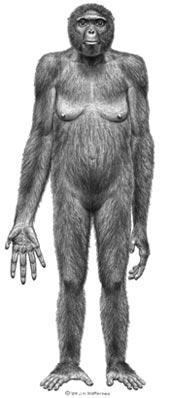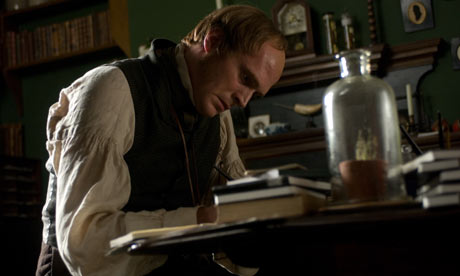
Siguiendo lo publicado en la revista Science sobre el descubrimiento y estudio del esqueleto parcial de una hembra de 4.4 millones de años apodada "Ardi," Discovery Channel presenta un estreno mundial el domingo, 11 de octubre, a las 21:00 horas. Este programa titulado ARDI AL DESCUBIERTO, documenta la intensa investigación realizada en los fósiles de un Ardipithecus ramidus, liderada por esta prestigiosa publicación.
La investigación, que comenzó en el desierto de Etiopía hace 17 años, ahora escribe un nuevo capítulo sobre la evolución del hombre, revelando los primeros pasos evolutivos de nuestros ancestros tomados luego de divergir de un antepasado común, que en su día compartimos con los chimpancés. El esqueleto de "Ardi”, las piedras, suelo, plantas y animales que formaban parte de su vida fueron analizados en laboratorios de todo el mundo, para que ahora los científicos publiquen sus descubrimientos en la prestigiosa revista Science.
"Ardi" es ahora el esqueleto mas viejo (homínido) de nuestra rama del árbol de la familia de los primates. Estos descubrimientos etíopes revelan un grado muy temprano de la evolución del hombre en África, anterior al famoso Australopithecus apodado "Lucy". El Ardipithecus era una criatura de ambientes boscosos con cerebro pequeño, brazos largos y piernas cortas. Tanto la pelvis como los pies demuestran su forma primitiva de caminar con las dos piernas en el suelo, aunque el Ardipithecus también era un excelente trepador de árboles, con dedos largos y grandes pulgares que le permitían agarrarse con los pies como un mono. Los descubrimientos responden a viejas preguntas sobre cómo los homínidos se convirtieron en bipedales.
El equipo de investigación internacional sopesó el alcance del proyecto y sus resultados: "Estos son los resultados de una misión científica a nuestro profundo pasado africano”, manifestó el geólogo y co-director del proyecto, Dr. Giday WoldeGabrie, del Laboratorio Nacional de Los Álamos. "La anatomía que describimos en estos documentos altera fundamentalmente nuestra comprensión de los orígenes del hombre y de su temprana evolución”, comentó el profesor C. Owen Lovejoy, especialista en anatomía y biología evolutiva de la Kent State University. Tim White, profesor de paleontología y co-director del proyecto del Centro de Investigación de Evolución Humana de la Universidad californiana de Berkeley, añadió: "El Ardipithecus no es un chimpancé. No es un humano. Es lo que solíamos ser”.
ARDI AL DESCUBIERTO comienza su historia con el descubrimiento en 1974 de un Australopithecus afarensis en Hadar, nordeste de Etiopía. Apodado "Lucy," este viejo esqueleto de 3.2 millones de años de antigüedad, era hasta aquel entonces el esqueleto homínido mas antiguo jamás encontrado. Conforme a los documentos especiales de Discovery Channel, este título le fue arrebatado a “Lucy” veinte años más tarde, concretamente en 1994, por el descubrimiento de "Ardi" en la región etíope de Afar. Un equipo de elite de expertos internacionales necesitó los quince años siguientes para ensamblar meticulosamente y con mucha delicadeza a “Ardi” y a su mundo perdido, con la intención de revelar su importancia y significado.
¿Quién es Ardi?
El equipo del proyecto Valle Inundado (“Middle Awash”) trabajó durante tres años para excavar el esqueleto de Ardi en un lugar llamado Aramis, situado en el valle del Rift de la región Afar de Etiopía. El esfuerzo de recuperación involucró el trabajo de docenas de científicos de todo el mundo.
Cuando el esfuerzo de recuperación del esqueleto finalizó en 1997, el equipo había recuperado más de 125 piezas de una hembra de 4.4 millones de años de antigüedad, el esqueleto homínido más viejo jamás encontrado.
Pertenecía a una nueva criatura que los científicos clasificaron bajo el nombre de Ardipithecus ramidus. El nombre proviene del lenguaje Afar en honor a los que todavía habitan el lugar. Ardipithecus significa “mono de tierra”, mientras ramidus significa “raíz”.
El descubrimiento de este bípedo de ambientes boscosos de 4.4 millones de años de antigüedad, con los caninos pequeños, se relaciona con nuestra anatomía y fisiología sexual única, incluso con nuestras familias y nuestra forma de caminar, todos podemos estar fundamentalmente ligados a él. Y de una forma mucho más ancestral de lo que jamás imaginamos.
¿QUÉ NOS APORTA ARDI?
- Ardi es el esqueleto homínido más viejo jamás localizado.
- Los primeros homínidos se desarrollaron en un ambiente boscoso.
- Ardi niega la teoría de que nuestro último antepasado común con los grandes monos se parecía a un chimpancé.
- La transición a la bipedalidad y el cambio en la función canina ocurrió bastante antes e independientemente después de la definición de las características de los homínidos.
- Los caninos pequeños en los Ardipithecus indican un cambio profundo en el complejo comportamiento social de los primeros homínidos.
- La bipedalidad debe haber formado parte de una adaptación más grande que proporcionó una ventaja biológica importante a los primeros homínidos.
No olviden verlo por discovery channel, se emitirá el domingo, 11 de octubre, a las 21:00 horas.

Saludillos!!

La investigación, que comenzó en el desierto de Etiopía hace 17 años, ahora escribe un nuevo capítulo sobre la evolución del hombre, revelando los primeros pasos evolutivos de nuestros ancestros tomados luego de divergir de un antepasado común, que en su día compartimos con los chimpancés. El esqueleto de "Ardi”, las piedras, suelo, plantas y animales que formaban parte de su vida fueron analizados en laboratorios de todo el mundo, para que ahora los científicos publiquen sus descubrimientos en la prestigiosa revista Science.
"Ardi" es ahora el esqueleto mas viejo (homínido) de nuestra rama del árbol de la familia de los primates. Estos descubrimientos etíopes revelan un grado muy temprano de la evolución del hombre en África, anterior al famoso Australopithecus apodado "Lucy". El Ardipithecus era una criatura de ambientes boscosos con cerebro pequeño, brazos largos y piernas cortas. Tanto la pelvis como los pies demuestran su forma primitiva de caminar con las dos piernas en el suelo, aunque el Ardipithecus también era un excelente trepador de árboles, con dedos largos y grandes pulgares que le permitían agarrarse con los pies como un mono. Los descubrimientos responden a viejas preguntas sobre cómo los homínidos se convirtieron en bipedales.
El equipo de investigación internacional sopesó el alcance del proyecto y sus resultados: "Estos son los resultados de una misión científica a nuestro profundo pasado africano”, manifestó el geólogo y co-director del proyecto, Dr. Giday WoldeGabrie, del Laboratorio Nacional de Los Álamos. "La anatomía que describimos en estos documentos altera fundamentalmente nuestra comprensión de los orígenes del hombre y de su temprana evolución”, comentó el profesor C. Owen Lovejoy, especialista en anatomía y biología evolutiva de la Kent State University. Tim White, profesor de paleontología y co-director del proyecto del Centro de Investigación de Evolución Humana de la Universidad californiana de Berkeley, añadió: "El Ardipithecus no es un chimpancé. No es un humano. Es lo que solíamos ser”.
ARDI AL DESCUBIERTO comienza su historia con el descubrimiento en 1974 de un Australopithecus afarensis en Hadar, nordeste de Etiopía. Apodado "Lucy," este viejo esqueleto de 3.2 millones de años de antigüedad, era hasta aquel entonces el esqueleto homínido mas antiguo jamás encontrado. Conforme a los documentos especiales de Discovery Channel, este título le fue arrebatado a “Lucy” veinte años más tarde, concretamente en 1994, por el descubrimiento de "Ardi" en la región etíope de Afar. Un equipo de elite de expertos internacionales necesitó los quince años siguientes para ensamblar meticulosamente y con mucha delicadeza a “Ardi” y a su mundo perdido, con la intención de revelar su importancia y significado.
¿Quién es Ardi?
El equipo del proyecto Valle Inundado (“Middle Awash”) trabajó durante tres años para excavar el esqueleto de Ardi en un lugar llamado Aramis, situado en el valle del Rift de la región Afar de Etiopía. El esfuerzo de recuperación involucró el trabajo de docenas de científicos de todo el mundo.
Cuando el esfuerzo de recuperación del esqueleto finalizó en 1997, el equipo había recuperado más de 125 piezas de una hembra de 4.4 millones de años de antigüedad, el esqueleto homínido más viejo jamás encontrado.
Pertenecía a una nueva criatura que los científicos clasificaron bajo el nombre de Ardipithecus ramidus. El nombre proviene del lenguaje Afar en honor a los que todavía habitan el lugar. Ardipithecus significa “mono de tierra”, mientras ramidus significa “raíz”.
El descubrimiento de este bípedo de ambientes boscosos de 4.4 millones de años de antigüedad, con los caninos pequeños, se relaciona con nuestra anatomía y fisiología sexual única, incluso con nuestras familias y nuestra forma de caminar, todos podemos estar fundamentalmente ligados a él. Y de una forma mucho más ancestral de lo que jamás imaginamos.
¿QUÉ NOS APORTA ARDI?
- Ardi es el esqueleto homínido más viejo jamás localizado.
- Los primeros homínidos se desarrollaron en un ambiente boscoso.
- Ardi niega la teoría de que nuestro último antepasado común con los grandes monos se parecía a un chimpancé.
- La transición a la bipedalidad y el cambio en la función canina ocurrió bastante antes e independientemente después de la definición de las características de los homínidos.
- Los caninos pequeños en los Ardipithecus indican un cambio profundo en el complejo comportamiento social de los primeros homínidos.
- La bipedalidad debe haber formado parte de una adaptación más grande que proporcionó una ventaja biológica importante a los primeros homínidos.
No olviden verlo por discovery channel, se emitirá el domingo, 11 de octubre, a las 21:00 horas.

Saludillos!!



























 VS
VS




